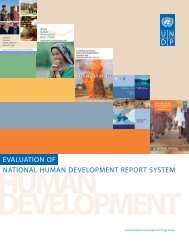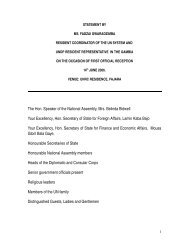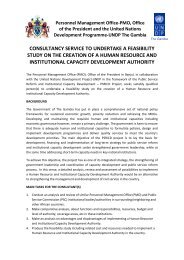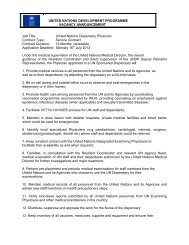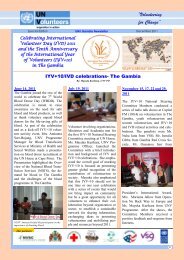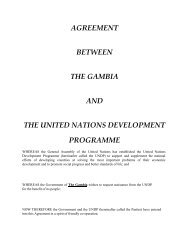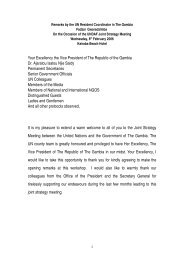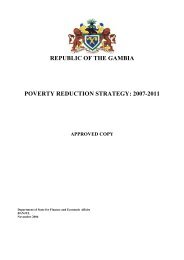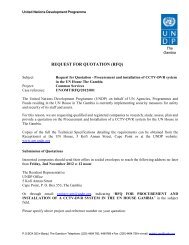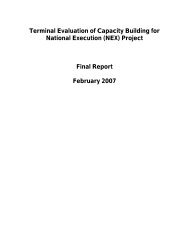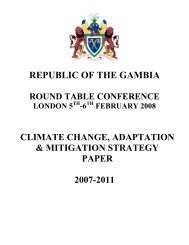Introduction - UNDP The Gambia
Introduction - UNDP The Gambia
Introduction - UNDP The Gambia
Create successful ePaper yourself
Turn your PDF publications into a flip-book with our unique Google optimized e-Paper software.
________________________________________________________________________________________________________________________<br />
recently resulted in serious staff attrition at<br />
the Project Management Unit of DOSE. <strong>The</strong><br />
unit lost the services of key trained personnel<br />
like the deputy project manager, procurement<br />
officer and construction manager. <strong>The</strong>se<br />
senior staff received extensive professional<br />
training, and their immediate replacement has<br />
not been easy and has had adverse effects on<br />
project management in the sector. Currently,<br />
there are too few teachers especially in the<br />
rural areas, and because of hostile conditions,<br />
many teachers are often reluctant to serve in<br />
these areas.<br />
<strong>The</strong> success of any education policy largely<br />
depends on the effectiveness of the<br />
management and organisational structures<br />
that are in place. <strong>The</strong> decentralisation<br />
programme is not fully resourced and the<br />
regional directorates are not fully<br />
functional. <strong>The</strong> high attrition rates of welltrained<br />
staff both at management and school<br />
levels undermine the degree of<br />
professionalism and efficiency of the<br />
management of the education system,<br />
resulting in low implementation rates, poor<br />
supervision of activities (especially the<br />
management of teacher supply) and issues of<br />
quality in the schools. Other weaknesses in<br />
the management of the sector include regional<br />
disparities in resources, staffing,<br />
implementation rate and supervision and<br />
monitoring. <strong>The</strong>se challenges affect<br />
performance, especially at the school levels.<br />
<strong>The</strong> low disbursement rate of project funds<br />
has often resulted in the under-utilisation of<br />
allocated resources.<br />
Decline in Budgeted Expenditure:<br />
Expenditures on education relative to the<br />
GDP declined from 4.3 per cent of the GDP<br />
to less than 3 per cent. Because of rising debt<br />
commitments, the share of the budget for<br />
education as a percentage of total recurrent<br />
funds has fallen from 17.1 per cent in 1999 to<br />
10.5 per cent in 2004.<br />
Thus education appears to have fallen as a<br />
government priority, meaning that the<br />
ambitious policy priorities set out in the<br />
National Policy for Education are unlikely to<br />
be achieved. Similarly, the PRSP objectives<br />
to improve the quality of education, increase<br />
the transition rate from upper basic to senior<br />
secondary school to 50 per cent, and increase<br />
the supply of teaching and learning materials<br />
are not likely to be met with falling budgetary<br />
resources.<br />
<strong>The</strong> Public Expenditure Report for the health<br />
sector (June 2004) reveals that the health<br />
system suffers from three major problems:<br />
lack of funding, severe shortage of health<br />
personnel and problems of access to<br />
services. <strong>The</strong> emergence of the HIV/AIDS<br />
epidemic further complicates the situation, as<br />
it requires additional resources and attention.<br />
<strong>The</strong> May 2002 Report on “Health and<br />
Poverty in <strong>The</strong> <strong>Gambia</strong>” established that<br />
although significant progress has been<br />
achieved in the development of the sector,<br />
considerable challenges need to be addressed<br />
to meet the MDG targets. Malnutrition,<br />
maternal and reproductive health, family<br />
planning, HIV/AIDS and malaria remain key<br />
priority areas for action.<br />
Also, access to quality services should be<br />
drastically improved in the rural areas for the<br />
benefit of the poor.<br />
Human resource management presents major<br />
challenges. Limited pay, and an inadequate<br />
management framework have undermined<br />
staff motivation, leading to acute human<br />
resource shortages in the rural areas.<br />
Furthermore, inter-sectoral public spending is<br />
not aligned with stated policy priorities, and<br />
the efficiency of spending in the sector leaves<br />
a lot to be desired. Intra-sectoral allocations<br />
of recurrent expenditures, mainly funded<br />
from domestic resources, reflect uneven<br />
efforts to implement the stated priority that is<br />
supposed to be accorded to primary health<br />
care. Between 1998 and 2002 the share of the<br />
sector’s resources spent on primary health<br />
care fell from about 40 per cent to<br />
approximately 30 per cent as a substantial<br />
portion of the department’s resource<br />
allocation was spent on tertiary services.<br />
________________________________________________________________________________________________<br />
Building Capacity for the Attainment of the Millennium Development Goals in <strong>The</strong> <strong>Gambia</strong> National Human Development Report 2005<br />
11




